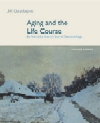1. How have attitudes toward the aged changed over time?
In non-Western cultures the elderly are often accorded great respect and esteem.
Were the aged venerated in the past in Europe and the United States? Some historians
have used evidence about the cultural practices toward old people elsewhere
to argue that the European Old World and New World aged were held in high esteem.
Others contend that veneration was merely a cultural ideal that was rarely practiced.
Evidence for the colonial period in the United States suggests that the ideal
of veneration did exist but that it did not extend to aged women, immigrants,
or members of minority groups. For much of the twentieth century the aged were viewed as isolated,
frail, and poor. Recently older people have been depicted as prosperous, selfish,
and politically powerful. Such stereotypes are not completely accurate. 2. Did elderly people live with their children in the past?
Extended family households consisting of two generations of married couples
were most common during one phase of the life course, not as the preferred living
arrangement. Typically, such households were formed when the parents retired
and passed their farms onto their children. 3. How did the rise of cities affect the way older people and their
families lived?
According to modernization theory, urbanization leaves the aged isolated in
rural areas. This is not entirely accurate, however, for in certain periods
overcrowding in cities forced families to live together in family households.
This was most likely to happen during bad economic times. If young adults had
trouble finding good jobs, they would continue living with their parents. 4. Have older people always been able to retire?
Retirement is not a new phenomenon. In the past, retirement was associated with
the ownership of land. Farmers would retire by giving their property to their
children in exchange for care in old age. People who owned no property could
not afford to retire and often worked at marginal jobs in old age. Skilled craft
workers also pooled their funds to provide retirement pensions for union members. 5. How did society care for the frail el-derly in the past?
Although the family has been the primary haven for the aged, there have always
been vulnerable older people who turned to the community for care in old age.
In the colonial period, care was often provided in the homes of local families.
As pauperism became associated with unemployed transients, almshouses replaced
other forms of public welfare. The almshouse experiment proved to be a failure,
and almshouses became defacto old-age institutions. Since the 1940s there has
been a growth in nursing homes, but even so fewer than 5 percent of people age
65 or older are residents of nursing homes. | 


 2002 McGraw-Hill Higher Education
2002 McGraw-Hill Higher Education